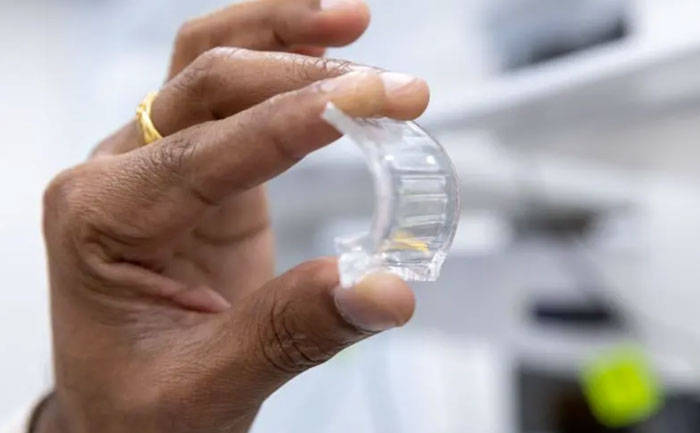 Technology peripherals
Technology peripherals
 AI
AI
 University of Melbourne uses 3D printing, low-cost materials to create flexible and transparent AR displays
University of Melbourne uses 3D printing, low-cost materials to create flexible and transparent AR displays
University of Melbourne uses 3D printing, low-cost materials to create flexible and transparent AR displays
(Nweon May 22, 2023) The University of Melbourne recently issued an article stating that through the cooperation between KDH Design Corporation and the Melbourne Nanofabrication Center, they have made a major breakthrough in the field of augmented reality technology and successfully used 3D printing and low-cost Cost Materials creates the world's first flexible and transparent AR display. "This development has the potential to revolutionize the use of AR across various industries and applications," the team said.

AR technology can overlay digital content into the real world, thereby enhancing users’ perception of the environment and real-time interaction. But creating flexible augmented reality technology that can adapt to light sources at different angles has been challenging. Current mainstream AR manufacturing relies on glass substrates, which involve time-consuming and expensive processes such as masking, lamination, or cutting.
So, the University of Melbourne collaborated with KDH Design Corporation and the Melbourne Nanofabrication Center to develop a transparent AR display using low-cost optical-quality polymer and plastic materials and made breakthrough progress, successfully using 3D printing and low-cost materials create the world's first flexible and transparent AR display.
Then, KDH Design Corporation, which is famous for manufacturing AR motorcycle helmets and military goggles, will apply this technology to AR glasses, AR sports goggles, AR headsets, AR automotive displays and other devices.

According to reports, the newly developed display is both flexible and multifunctional, allowing it to be bent and adapted to different shapes. This flexibility gives designers more freedom to adapt to various product form parameters. In addition, the display is transparent, ensuring that users have a natural and smooth perception of the real world while superimposing digital content.
By using 3D printing technology, teams can have precise control over design and production, resulting in higher quality products. It simultaneously opens up the possibility of cost-effective and scalable mass production.
The University of Melbourne stated that this breakthrough marks a major advancement in augmented reality technology and brings huge application potential. For example, in the gaming industry, flexible and transparent AR displays can be integrated into headsets to provide a more immersive gaming experience; in education, AR displays can be integrated into tools and simulations to promote interactivity and engaging Learning experience; in the field of healthcare, augmented reality displays can be used for medical training to help surgeons obtain real-time information during operations; in addition, potential applications can be extended to areas such as transportation and tourism.
KDH Design Corporation said that after four years of collaborative research, they have realized the ultimate AR technology envisioned. The technology is ultra-thin, energy-efficient and lightweight, making it suitable for near-eye applications such as AR glasses and goggles. The team next plans to apply the AR technology to transparent displays such as car windshields.
They further highlighted that collaboration with University of Melbourne researchers ensured the prototype was developed in line with their vision. They are now ready to commercialize this technology for a wide range of exciting applications.
The above is the detailed content of University of Melbourne uses 3D printing, low-cost materials to create flexible and transparent AR displays. For more information, please follow other related articles on the PHP Chinese website!

Hot AI Tools

Undresser.AI Undress
AI-powered app for creating realistic nude photos

AI Clothes Remover
Online AI tool for removing clothes from photos.

Undress AI Tool
Undress images for free

Clothoff.io
AI clothes remover

Video Face Swap
Swap faces in any video effortlessly with our completely free AI face swap tool!

Hot Article

Hot Tools

Notepad++7.3.1
Easy-to-use and free code editor

SublimeText3 Chinese version
Chinese version, very easy to use

Zend Studio 13.0.1
Powerful PHP integrated development environment

Dreamweaver CS6
Visual web development tools

SublimeText3 Mac version
God-level code editing software (SublimeText3)

Hot Topics
 1386
1386
 52
52
 I Tried Vibe Coding with Cursor AI and It's Amazing!
Mar 20, 2025 pm 03:34 PM
I Tried Vibe Coding with Cursor AI and It's Amazing!
Mar 20, 2025 pm 03:34 PM
Vibe coding is reshaping the world of software development by letting us create applications using natural language instead of endless lines of code. Inspired by visionaries like Andrej Karpathy, this innovative approach lets dev
 Top 5 GenAI Launches of February 2025: GPT-4.5, Grok-3 & More!
Mar 22, 2025 am 10:58 AM
Top 5 GenAI Launches of February 2025: GPT-4.5, Grok-3 & More!
Mar 22, 2025 am 10:58 AM
February 2025 has been yet another game-changing month for generative AI, bringing us some of the most anticipated model upgrades and groundbreaking new features. From xAI’s Grok 3 and Anthropic’s Claude 3.7 Sonnet, to OpenAI’s G
 How to Use YOLO v12 for Object Detection?
Mar 22, 2025 am 11:07 AM
How to Use YOLO v12 for Object Detection?
Mar 22, 2025 am 11:07 AM
YOLO (You Only Look Once) has been a leading real-time object detection framework, with each iteration improving upon the previous versions. The latest version YOLO v12 introduces advancements that significantly enhance accuracy
 Best AI Art Generators (Free & Paid) for Creative Projects
Apr 02, 2025 pm 06:10 PM
Best AI Art Generators (Free & Paid) for Creative Projects
Apr 02, 2025 pm 06:10 PM
The article reviews top AI art generators, discussing their features, suitability for creative projects, and value. It highlights Midjourney as the best value for professionals and recommends DALL-E 2 for high-quality, customizable art.
 Is ChatGPT 4 O available?
Mar 28, 2025 pm 05:29 PM
Is ChatGPT 4 O available?
Mar 28, 2025 pm 05:29 PM
ChatGPT 4 is currently available and widely used, demonstrating significant improvements in understanding context and generating coherent responses compared to its predecessors like ChatGPT 3.5. Future developments may include more personalized interactions and real-time data processing capabilities, further enhancing its potential for various applications.
 Best AI Chatbots Compared (ChatGPT, Gemini, Claude & More)
Apr 02, 2025 pm 06:09 PM
Best AI Chatbots Compared (ChatGPT, Gemini, Claude & More)
Apr 02, 2025 pm 06:09 PM
The article compares top AI chatbots like ChatGPT, Gemini, and Claude, focusing on their unique features, customization options, and performance in natural language processing and reliability.
 How to Use Mistral OCR for Your Next RAG Model
Mar 21, 2025 am 11:11 AM
How to Use Mistral OCR for Your Next RAG Model
Mar 21, 2025 am 11:11 AM
Mistral OCR: Revolutionizing Retrieval-Augmented Generation with Multimodal Document Understanding Retrieval-Augmented Generation (RAG) systems have significantly advanced AI capabilities, enabling access to vast data stores for more informed respons
 Top AI Writing Assistants to Boost Your Content Creation
Apr 02, 2025 pm 06:11 PM
Top AI Writing Assistants to Boost Your Content Creation
Apr 02, 2025 pm 06:11 PM
The article discusses top AI writing assistants like Grammarly, Jasper, Copy.ai, Writesonic, and Rytr, focusing on their unique features for content creation. It argues that Jasper excels in SEO optimization, while AI tools help maintain tone consist



